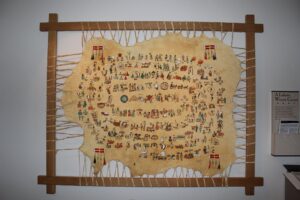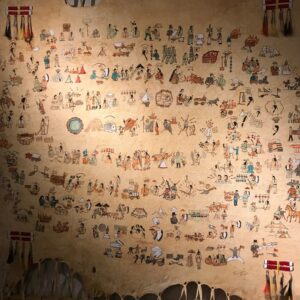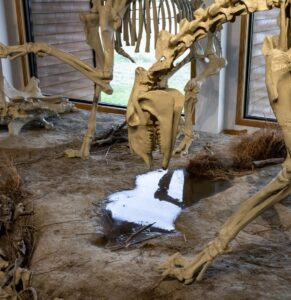Our Many Trips Around The Sun: Inspired by Agate Fossil Beds
Summary:
This resource is available to support place-based writing outside anytime of year and comes with related resources and age-level recommendations. Originally developed for Write Out (writeout.nwp.org).“Time limits are fictional. Losing all sense of time is actually the way to reality. We use clocks and calendars for convenience sake, not because that kind of time is real.” —Leslie Marmon Silko
Every culture has a unique sense of “time” and how they track it. Do you see time as linear or sequential? Do you measure it down to the hour, minute or second? The planet Earth also has its own ways of marking time which we can learn about through sediments and fossils. At the Agate Fossil Beds National Monument in Nebraska, we can imagine all these different time scales and markings since it is a place where paleontologists unearthed the Age of Mammals as well as the ancestral homeland of the Lakota people.
Use these different scales and marks of time to consider the passage of time where you live.
Writing “Sparks”
As educator Peter Elbow writes, “the most effective way … to improve your writing is to do free writing exercises regularly.” Use these writing “sparks” to get your free writing started. Use a notebook or a journal, go digital or stay analog, feel free to incorporate images and multimedia; use or experiment with approaches that work best for you.
Spark—Go back to a memorable time – for you and/or your community. How would you pictorialize it? What would the symbols include? What would you leave out? How are the pieces connected?
Content focus: Lakota Winter Counts
Age-level recommendations: All ages
Time: Writing time as needed
While modern Americans track time and events on paper calendars or digital devices, the Lakota traditionally used “Winter Counts” where the year runs from the first snowfall to the next year’s first snowfall.
Each year would have a name and pictograph that represented it, based on the most memorable thing that happened that year. The tribal elders consulted with the keeper of the count to find a consensus representative event. The Winter Counts are often laid out in a spiral or a circular pattern. This matches the Lakota perception of time as cyclical instead of linear.


The “Running Water” Winter Count was created by Dawn Little Sky to mark the events impacting the lives of James Cook and Red Cloud at the current location of the Agate Fossil Beds National Monument.
Based on this idea of the Winter Count, go back to a memorable time in your own life (or that of your community). How would you pictorialize it? What would the symbols include? What would you leave out? How are the pieces connected?
Spark—What would a paleontologist 23 millions years from now say about the fossils we leave behind?
Content focus: Geological time
Age-level recommendations: All ages
Time: Writing time as needed
Through the deposition of sediments, we can tell where the Agate Paleoriver flowed and watered our Miocene animals. Through the overlying fossilized roots of plants, we can see the cycles of drought, flood and volcanic ash. The same cycle that led to the flourishing of the huge herds of menoceras and then to their deaths in the drying watering hole.

These cycles, amplified by over-allocation and climate change, are in play once again. This is most dramatically seen at National Park sites in the Southwest, such as Lake Meed National Recreation Area.
What would a hypothetical paleontologist 23 millions years from now say about the fossils we leave behind?
Sharing your writing
Writing outdoors provides a wonderful opportunity to share your writing with others. Here are a few ideas how do this whether you are in person or at a distance from each other:
- Come together in a circle to share your writing, or an excerpt from your writing (passing should also always be an option); if you aren’t in person, set up an online video conference to do this;
- Develop a collaboration on the fly by having each writer share one line of their work to add to a greater whole; if you aren’t in person, you can create an email address, hashtag and/or online form for individuals to submit their selections;
- Set up a “gallery” of writing which could support browsing, feedback and/or response; this is especially useful if the writing includes more than just text but also images, video, sound. This can happen in person or online using a shared collaborative space like Google Jamboard, Padlet etc.;
- Especially during Write Out, share your writing by posting on social media using the hashtag #writeout
Related resources
Below are related resources gathered to further support inquiry and exploration of this topic. If you have additional resources to recommend, please share them online via the hashtag #writeout
Agate Fossil Beds National Monument: In the early 1900s, paleontologists unearthed the Age of Mammals when they found full skeletons of extinct Miocene mammals in the hills of Nebraska — species previously only known through fragments. At the same time, an age of friendship began between rancher James Cook and Chief Red Cloud of the Lakota. These two unprecedented events are preserved and protected here… at Agate Fossil Beds.
Lakota Winter Counts: Two Smithsonian experts describe the Lakota tradition of creating Winter Counts as a way of recording events. This video is part of the “Tools” exhibition at Cooper Hewitt, Smithsonian Design Museum from December 2014 to May 2015.
“Running Water” Winter Count: Artist Dawn Little Sky (Lakota), who lived on the Pine Ridge Reservation, created this modern chronology of events impacting the lives of James Cook and Red Cloud and the place called Agate Fossil Beds. Events are portrayed yearly from the birth of Red Cloud in 1821 until the death of James Cook in 1942.
Writing Marathon at Agate Fossil Beds with the Nebraska Writing Project: This marathon, co-created by the Nebraska Writing Project with Park Service Rangers from Agate Fossil Beds National Monument, is an invitation to step out and explore Agate with a different lens. It’s your chance to digitally wander the park virtually and to share your observations with each other through writing.
Write Out: Write Out is a free two-week celebration of writing, making, and sharing inspired by the great outdoors, and was created through a partnership of the National Writing Project and the National Park Service. It is a public invitation to get out and create that is supported with a series of online activities, made especially for educators, students, and families, to explore national parks and other public spaces. The goal is to connect and learn through place-based writing and sharing using the common hashtag #writeout.
Image source: Sunrise at Agate by Ranger Mar

